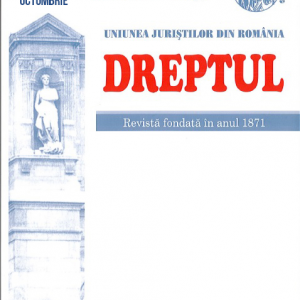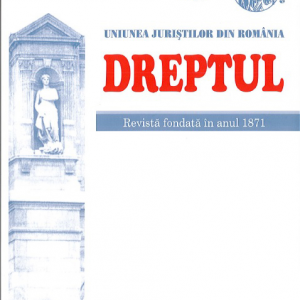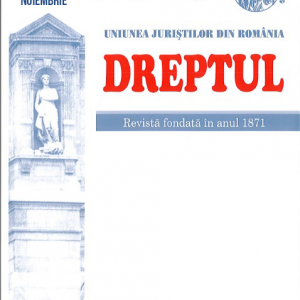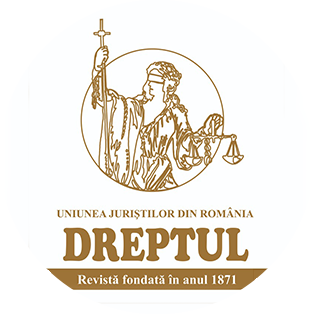-
 The regulation of crimes in the field of the illegal removal and transplant of organs, tissues and cells of human origin at the level of each country is extremely important due to the big social danger of these crimes and the importance of the social values protected by their incrimination, values regarding the life and the physical and mental integrity of the members of society, as well as the respect due to the memory of deceased persons. In this respect, at the level of the European Union, the Directive 2004/23/EC of the European Parliament and of the Council, of 31 March 2004, on setting standards of quality and safety for the donation, procurement, testing, processing, preservation, storage and distribution of human tissues and cells was adopted. There are numerous European countries in which the crimes in the field of the illegal removal and transplant of organs, tissues and cells of human origin are incriminated in the Criminal Code. Their experience should also be followed by Romania, where, at present, the field is regulated by Law no. 95/2006 on healthcare reform, as subsequently amended and supplemented.
The regulation of crimes in the field of the illegal removal and transplant of organs, tissues and cells of human origin at the level of each country is extremely important due to the big social danger of these crimes and the importance of the social values protected by their incrimination, values regarding the life and the physical and mental integrity of the members of society, as well as the respect due to the memory of deceased persons. In this respect, at the level of the European Union, the Directive 2004/23/EC of the European Parliament and of the Council, of 31 March 2004, on setting standards of quality and safety for the donation, procurement, testing, processing, preservation, storage and distribution of human tissues and cells was adopted. There are numerous European countries in which the crimes in the field of the illegal removal and transplant of organs, tissues and cells of human origin are incriminated in the Criminal Code. Their experience should also be followed by Romania, where, at present, the field is regulated by Law no. 95/2006 on healthcare reform, as subsequently amended and supplemented. -
 The author examines synthetically the changes brought to the institutional structure of the European Union by the Treaty of Lisbon. For this purpose, the author presents the essential institutional changes brought to: the European Parliament; the European Council; the Council; the European Commission (the Commission); the Court of Justice of the European Union.
The author examines synthetically the changes brought to the institutional structure of the European Union by the Treaty of Lisbon. For this purpose, the author presents the essential institutional changes brought to: the European Parliament; the European Council; the Council; the European Commission (the Commission); the Court of Justice of the European Union. -
 The author states that the criminal trial should take place with celerity, within a reasonable period of time, according to art. 6 of the Convention for the Protection of Human Rights and Fundamental Freedoms. In this context, the submission by the defendants of applications to notify the Constitutional Court of exceptions of unconstitutionality that were previously dismissed numerous times represents an abuse of right committed for the purpose of procrastinating the resolution of the cases.
The author states that the criminal trial should take place with celerity, within a reasonable period of time, according to art. 6 of the Convention for the Protection of Human Rights and Fundamental Freedoms. In this context, the submission by the defendants of applications to notify the Constitutional Court of exceptions of unconstitutionality that were previously dismissed numerous times represents an abuse of right committed for the purpose of procrastinating the resolution of the cases. -
 As regards the possibility to maintain conditional release if, following a merger of penalties, a penalty equal to that from which the convict was released on parole is enforced, two solutions are possible. The first solution consists in deducting only the actually served penalty and incarcerating the convicted person again, and the second solution consists in considering the entire penalty served. The resolution of the controversy depends on the opinion adopted as regards the legal nature of conditional release.
As regards the possibility to maintain conditional release if, following a merger of penalties, a penalty equal to that from which the convict was released on parole is enforced, two solutions are possible. The first solution consists in deducting only the actually served penalty and incarcerating the convicted person again, and the second solution consists in considering the entire penalty served. The resolution of the controversy depends on the opinion adopted as regards the legal nature of conditional release. -
 After examining the criminal rules contained in the Government Emergency Ordinance no. 202/2002, the authors formulate several proposals de lege ferenda regarding the crimes regulated by this piece of legislation.
After examining the criminal rules contained in the Government Emergency Ordinance no. 202/2002, the authors formulate several proposals de lege ferenda regarding the crimes regulated by this piece of legislation. -
 In this study, after a presentation regarding the establishment of the Commonwealth of Independent States (C.I.S.), in December 1991, the author examines: the legal personality of this international organization; its constituent bodies; the member states of the organization; CIS – present and prospects.
In this study, after a presentation regarding the establishment of the Commonwealth of Independent States (C.I.S.), in December 1991, the author examines: the legal personality of this international organization; its constituent bodies; the member states of the organization; CIS – present and prospects. -
 According to the regulations of the Romanian pension law, persons who, prior to 1 April 2001, worked in the work groups I and II benefit of a series of easements at the calculation of pension rights, as well as of the reduction of the standard retirement age. In this study, the author examines a rich and interesting case law of the classification into the work groups I and II – according to Orders no. 50/1990 and no. 125/1990 issued by the Minister of Labor and Social Protection, the Minister of Health and the President of the National Labor Protection Commission, with the mentioning that, under certain conditions, these Orders also apply to the persons retiring subsequent to 1 April 2001, but who carried out activities classified in the work groups I and II (according to the above-mentioned Orders) prior to such date.
According to the regulations of the Romanian pension law, persons who, prior to 1 April 2001, worked in the work groups I and II benefit of a series of easements at the calculation of pension rights, as well as of the reduction of the standard retirement age. In this study, the author examines a rich and interesting case law of the classification into the work groups I and II – according to Orders no. 50/1990 and no. 125/1990 issued by the Minister of Labor and Social Protection, the Minister of Health and the President of the National Labor Protection Commission, with the mentioning that, under certain conditions, these Orders also apply to the persons retiring subsequent to 1 April 2001, but who carried out activities classified in the work groups I and II (according to the above-mentioned Orders) prior to such date. -
 This study deals with the issue of forced distinctiveness, a legal mechanism that is essential for the matter of the trade mark law, but which is not generally thoroughly treated in the Romanian specialized literature, despite the rich case law it generates. Forced distinctiveness refers to the situation in which a sign that is likely to be represented graphically, but which initially lacks a distinctive nature, acquires distinctiveness following its use. Throughout the study, the author examines the legal nature of forced distinctiveness, from the point of view of the Romanian legislation and the European regulations, with references to the essential case law in this matter. Thus, in the first part, the author reviews the signs likely to acquire distinctiveness by use and in the second part, he examines the conditions of forced distinctiveness, as well as the criteria on which the assessment of the competent authority is based.
This study deals with the issue of forced distinctiveness, a legal mechanism that is essential for the matter of the trade mark law, but which is not generally thoroughly treated in the Romanian specialized literature, despite the rich case law it generates. Forced distinctiveness refers to the situation in which a sign that is likely to be represented graphically, but which initially lacks a distinctive nature, acquires distinctiveness following its use. Throughout the study, the author examines the legal nature of forced distinctiveness, from the point of view of the Romanian legislation and the European regulations, with references to the essential case law in this matter. Thus, in the first part, the author reviews the signs likely to acquire distinctiveness by use and in the second part, he examines the conditions of forced distinctiveness, as well as the criteria on which the assessment of the competent authority is based. -
 The Civil Code expressly introduces the porte-fort convention or the promise of another’s deed in Article 1283, regulation which takes over the institution which was created in the doctrine of the Civil Code of 1865. The current codification places the institution in the section regarding the effects of the contract, but in a subsection distinct from the one devoted to the consecration of the principle of relativity of the effects of the contract. Although the systematic treatment of the principle inevitably implies the exploration of the controversies on the real or apparent exceptions, the incorporation of the analysis of the porte-fort convention in this framework has made the novelty of this legal figure somehow obscured. This article intends to make a critical analysis of the porte-fort convention in the regulation of Article 1283 of the Civil Code also from the perspective of the comparative law, by pursuing in detail the legal regime in terms of notion, forms, nature, legal characters, conditions of validity and effects, as well as the applications of this institution.
The Civil Code expressly introduces the porte-fort convention or the promise of another’s deed in Article 1283, regulation which takes over the institution which was created in the doctrine of the Civil Code of 1865. The current codification places the institution in the section regarding the effects of the contract, but in a subsection distinct from the one devoted to the consecration of the principle of relativity of the effects of the contract. Although the systematic treatment of the principle inevitably implies the exploration of the controversies on the real or apparent exceptions, the incorporation of the analysis of the porte-fort convention in this framework has made the novelty of this legal figure somehow obscured. This article intends to make a critical analysis of the porte-fort convention in the regulation of Article 1283 of the Civil Code also from the perspective of the comparative law, by pursuing in detail the legal regime in terms of notion, forms, nature, legal characters, conditions of validity and effects, as well as the applications of this institution. -
 The author, starting from a personal opinion, expressed in a previous study (published in the year 2000), namely that the employment relationship of the public servant represents a typical form of a legal employment relationship, a relationship that, although different from the individual employment contract (the archetype of the legal employment relationship), is not yet essentially different from the latter and, consequently, from a logical and legal point of view, the employment relationship of the public servant is a basic component of the labor law (legislation), emphasizes afterwards that, in recent years, one can note, from the legal point of view, a continuous reduction of differences between the legal employment relationship of employees and that of public servants. Further on, the author presents the typology of the current legal employment relationships, namely: the legal relationship of employees (generated by the conclusion of the individual employment contract, regulated by the Labor Code); the legal employment relationship of public servants (generated by Law no. 188/ 1999 on the Statute of Public Servants or by some statutes regarding special categories of public servants such as, for instance, police officers, diplomats and consuls, customs personnel etc.); the legal employment relationship of career military personnel (non-commissioned officers and officers – Law no. 80/1995); the legal relationship of persons holding a public office position; the legal employment relationship of magistrates (whose statute is subject to Law no. 303/ 2004); the legal employment relationship between the cooperative company and the cooperative members (Law no. 1/2005). As regards this typology of legal employment relationships, the author believes it is fundamentally erroneous to limit the object of labor law exclusively to the legal employment relationship of employees (regulated by the Labor Code), and firmly believes that all the above-mentioned legal employment relationships are, in his monist vision of the labor law, components of the Romanian labor law, whose summa divisio is made of the common labor law (regarding the legal employment relationship of employees, based upon the individual employment contract that is regulated mainly by the Labor Code provisions) and, on the other hand, of the special labor law (comprising the legal employment relationships of civil and military servants, persons holding public office positions, magistrates and cooperative members), a special labor law focused on regulations other than the Labor Code, but for which the Labor Code still represents common law.
The author, starting from a personal opinion, expressed in a previous study (published in the year 2000), namely that the employment relationship of the public servant represents a typical form of a legal employment relationship, a relationship that, although different from the individual employment contract (the archetype of the legal employment relationship), is not yet essentially different from the latter and, consequently, from a logical and legal point of view, the employment relationship of the public servant is a basic component of the labor law (legislation), emphasizes afterwards that, in recent years, one can note, from the legal point of view, a continuous reduction of differences between the legal employment relationship of employees and that of public servants. Further on, the author presents the typology of the current legal employment relationships, namely: the legal relationship of employees (generated by the conclusion of the individual employment contract, regulated by the Labor Code); the legal employment relationship of public servants (generated by Law no. 188/ 1999 on the Statute of Public Servants or by some statutes regarding special categories of public servants such as, for instance, police officers, diplomats and consuls, customs personnel etc.); the legal employment relationship of career military personnel (non-commissioned officers and officers – Law no. 80/1995); the legal relationship of persons holding a public office position; the legal employment relationship of magistrates (whose statute is subject to Law no. 303/ 2004); the legal employment relationship between the cooperative company and the cooperative members (Law no. 1/2005). As regards this typology of legal employment relationships, the author believes it is fundamentally erroneous to limit the object of labor law exclusively to the legal employment relationship of employees (regulated by the Labor Code), and firmly believes that all the above-mentioned legal employment relationships are, in his monist vision of the labor law, components of the Romanian labor law, whose summa divisio is made of the common labor law (regarding the legal employment relationship of employees, based upon the individual employment contract that is regulated mainly by the Labor Code provisions) and, on the other hand, of the special labor law (comprising the legal employment relationships of civil and military servants, persons holding public office positions, magistrates and cooperative members), a special labor law focused on regulations other than the Labor Code, but for which the Labor Code still represents common law. -
 The examination of the constitutionality of the Government Emergency Ordinance no. 134/2005 has significant implications as regards the legality of the activity of one of the fundamental institutions of the State, which was established for the discovery and punishment of corruption actions. The authors intend to bring clarifications regarding this matter and the need to remove any doubts regarding the complete constitutionality of the AntiCorruption General Directorate.
The examination of the constitutionality of the Government Emergency Ordinance no. 134/2005 has significant implications as regards the legality of the activity of one of the fundamental institutions of the State, which was established for the discovery and punishment of corruption actions. The authors intend to bring clarifications regarding this matter and the need to remove any doubts regarding the complete constitutionality of the AntiCorruption General Directorate. -
 The new Romanian Civil Code (Law no. 287/2009), voted by the Parliament, promulgated, and published (on 24 July 2009), but not yet in force, regulates the following matrimonial regimes: the regime of legal community; the regime of conventional community; the regime of separation of property. In this study, the regime of separation of property is examined, in the light of art. 360–365 and art. 370–372 of the new Civil Code. In this regard, the author examines the categories of property under the regime of separation of property; the personal property of the spouses, the common property per shares of the spouses; the use of one spouse’s property by the other spouse; the liability of spouses for the personal obligations.
The new Romanian Civil Code (Law no. 287/2009), voted by the Parliament, promulgated, and published (on 24 July 2009), but not yet in force, regulates the following matrimonial regimes: the regime of legal community; the regime of conventional community; the regime of separation of property. In this study, the regime of separation of property is examined, in the light of art. 360–365 and art. 370–372 of the new Civil Code. In this regard, the author examines the categories of property under the regime of separation of property; the personal property of the spouses, the common property per shares of the spouses; the use of one spouse’s property by the other spouse; the liability of spouses for the personal obligations.
